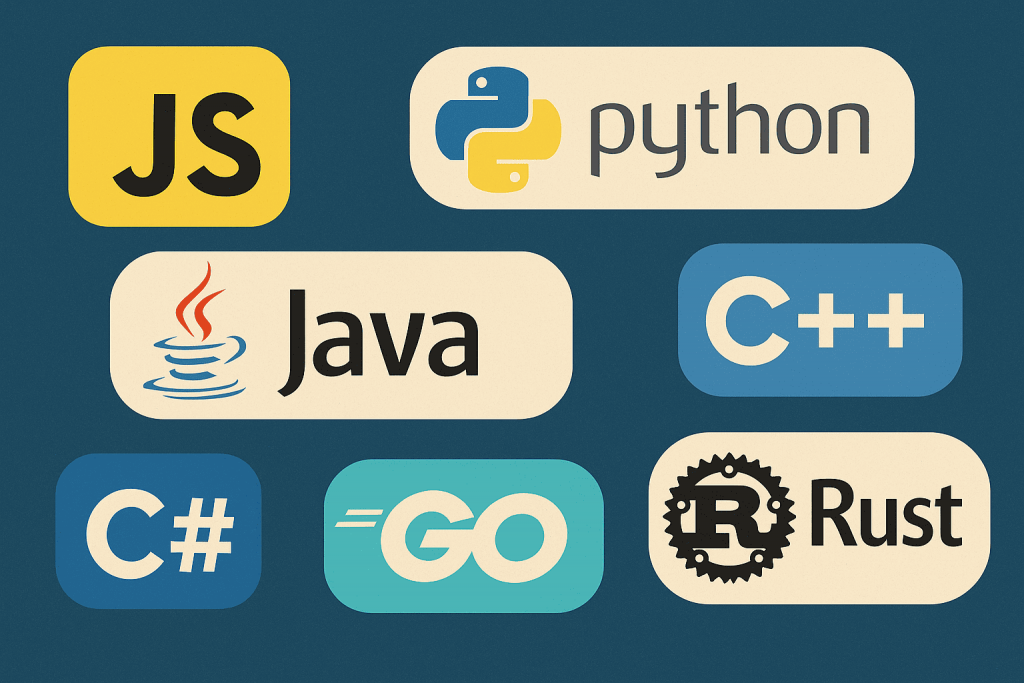
When developing a website or a mobile application, it is important to choose tools that won’t disappear in a few years. RX-NAME works daily with projects written in different languages. Experience shows that some technologies remain popular for decades, thanks to large communities, constant updates, and a wide range of use cases. Let’s take a look at several programming languages that are highly likely to stay relevant for many years to come.
JavaScript and TypeScript
JavaScript is the foundation of modern web applications. According to research, it is used by more than 98.9% of websites; it remains the most widespread language in surveys, while the latest ECMAScript versions regularly add new features, such as improved array methods and date processing APIs. Beyond the frontend, JavaScript is also used on the server side via Node.js, allowing developers to build a full stack using one language.
TypeScript is a superset of JavaScript with static typing support. It simplifies large-scale project development by helping detect errors during code writing and supporting the object-oriented approach. Many cloud services actively use TypeScript, so this language is expected to maintain its popularity alongside JavaScript.
Python
Python has earned the reputation of a universal tool thanks to its simple, almost “English-like” syntax and vast library ecosystem. The new Python 3.13 version introduces faster bytecode execution, optimized memory management, and even an experimental JIT compiler, making the language faster. With libraries like TensorFlow, PyTorch, NumPy, and Pandas, Python remains the backbone of artificial intelligence and data analysis. Despite new languages appearing, experts predict its popularity will continue to grow for at least the next decade.
Java
Java has existed for more than 29 years, yet it still ranks among the top three languages in popularity. It remains in demand due to its versatility: it is used to develop Android apps, enterprise systems, and web services. Although Java can be slower and harder to learn, its platform independence allows programs to run on different operating systems, saving time and resources during development.
Java enables the creation of high-performance, scalable, and secure systems capable of handling millions of requests per second. Continuous evolution and strong community support ensure that Java will continue to be a top choice for backend development and mobile apps.
C and C++
C and C++ are the foundation of operating systems, games, and embedded devices. For decades, C++ has been the “cornerstone of high-performance computing,” used to build game engines and operating systems. Today, the language continues to evolve to meet modern challenges—from security to artificial intelligence. The upcoming C++26 standard is expected to bring Pattern Matching templates, contracts for better reliability, SIMD parallelism for processing large datasets, and static reflection for metaprogramming.
High speed and fine-grained control over hardware resources make C and C++ indispensable for low-level systems, drivers, and IoT devices. Even with the rise of safer languages (such as Rust), C++ continues to improve, and its role in high-performance solutions will remain key.
C#
C# is Microsoft’s language that combines expressiveness with the powerful .NET ecosystem. In 2025, it remains one of the most popular languages: according to the TIOBE index (a monthly ranking of programming language popularity based on searches, job postings, and educational materials across sources), C# ranked fifth, while surveys show about one-third of developers use it.
The latest versions bring improvements: C# 13 allows working with ReadOnlySpan<T> without extra overhead and simplifies thread synchronization. C# has wide applications—from enterprise web apps to games on the Unity engine, which powers about 70% of mobile games. With .NET MAUI and Blazor, developers can create mobile, desktop, and web interfaces from a single codebase. All of this makes C# a strong long-term choice.
Go
Go (or Golang), created by Google, is known for its high performance and simplicity. It has built-in support for concurrency (goroutines), making it easier to write lightweight and scalable servers and cloud services. According to the TIOBE index, Go climbed from 13th to 7th place in 2024. It is widely used in infrastructure, as it powers Kubernetes and Docker. The new Go 1.23 version introduces improvements in loop syntax and telemetry tools, making development even more convenient.
With its simple type system, fast compiler, and open-source nature, Go is a reliable choice for microservices, cloud systems, and networking tools.
Rust
Rust is known for memory safety and concurrency guarantees without garbage collection. It is gaining popularity in the development of Internet of Things systems and blockchain solutions because it combines high speed with strong error handling. Rust has the potential to reshape system programming, gradually replacing C/C++ in areas where safety is critical. Thanks to its community and stable syntax, Rust has every chance of becoming a long-term player in the programming world.
Key Takeaway
The tech world is constantly changing, but some programming languages remain stable and effective tools. JavaScript and TypeScript dominate web development; Python stays universal for data science and AI; Java is a reliable base for business systems and mobile apps; C and C++ ensure high performance; C# blends .NET convenience with broad applications; Go simplifies building high-load services; Rust offers a safe alternative for system programming.
When launching a new project, it is important to consider not only the programming language but also the reliable platform where it will be hosted. Performance, scalability, and security depend both on the technologies used to build the application and the hosting where it runs. The right combination of these two factors will help ensure long-term stability and readiness for future growth.

Leave a Reply